The smart boxing machine market is estimated to be valued at USD 346.0 million in 2025 and is projected to reach USD 474.1 million by 2035, registering a compound annual growth rate (CAGR) of 3.2% over the forecast period. The figures show a steady progression from USD 346 million in 2025 to USD 392.5 million in 2029, highlighting how adoption is unfolding at a measured pace. This trajectory reflects the way the demand for intelligent fitness equipment has been encouraged by consumer preferences for interactive training, data-driven performance tracking, and personalized workout experiences.
While the growth rate is not among the highest in the connected fitness industry, the reliability of expansion signals a resilient base of enthusiasts and gyms willing to invest in equipment that combines exercise with real-time analytics. By 2035, the market value is expected to approach USD 474.1 million, which indicates that smart boxing machines will continue to capture a niche yet consistent demand. The CAGR points to a market where brand differentiation, quality of training modules, and integration with mobile applications will hold significant weight in consumer choice. Fitness brands that are able to merge combat sports training with entertainment and gamification are likely to benefit the most.
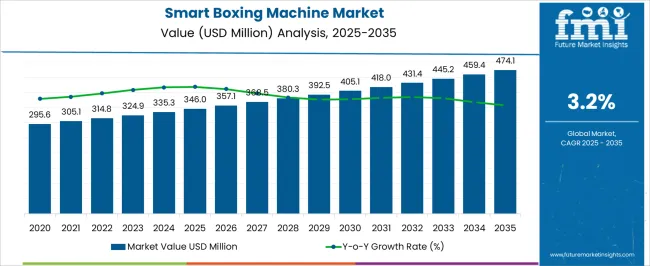
| Metric | Value |
|---|---|
| Smart Boxing Machine Market Estimated Value in (2025 E) | USD 346.0 million |
| Smart Boxing Machine Market Forecast Value in (2035 F) | USD 474.1 million |
| Forecast CAGR (2025 to 2035) | 3.2% |
The smart boxing machine market forms a niche yet rapidly growing segment within the broader fitness equipment industry, where it accounts for nearly 2-3% share, as interactive boxing machines are increasingly used in gyms, training centers, and home fitness setups. In the sports technology market, its share stands at around 1.5-2%, driven by the integration of motion sensors, AI-driven training programs, and performance analytics that enhance user experience and engagement.
Within the home gym and connected fitness market, the smart boxing machine segment holds about 3-4% share, benefiting from the rise of app-based workouts, at-home exercise demand, and hybrid fitness models. The entertainment and gaming systems market contributes around a 1-2% share, as gamified boxing machines combine exercise with interactive play, appealing to younger users and those seeking recreational workouts. Meanwhile, in the wearable devices and health monitoring market, smart boxing machines represent nearly 1% share, as they sync with fitness trackers and health apps to provide real-time feedback on calories, endurance, and performance metrics.
The smart boxing machine market is gaining momentum due to the integration of advanced sensor technologies, interactive training modules, and connected fitness ecosystems. Rising adoption in gyms, sports training centers, and home fitness setups has been driven by the increasing focus on performance tracking, personalized workout analytics, and immersive user experiences. Market growth is further supported by the proliferation of fitness technology startups and the incorporation of gamification features that enhance user engagement.
Manufacturers are investing in durable materials, ergonomic designs, and cloud-based software updates to extend product life cycles and improve functionality. Regional expansion is being facilitated by the growing penetration of connected devices and increased disposable income in emerging markets.
Additionally, strategic partnerships between equipment manufacturers and fitness chains are enhancing brand visibility and market adoption. Over the forecast period, technological advancements, combined with rising consumer interest in data-driven fitness solutions, are expected to sustain steady revenue growth and open opportunities for product diversification across various training environments.
The smart boxing machine market is segmented by type, power source, price range, application, distribution channel, and geographic regions. By type, the smart boxing machine market is divided into wall-mounted and floor-standing. In terms of power source, the smart boxing machine market is classified into Electric and battery-operated. Based on price range, the smart boxing machine market is segmented into Medium, Low, and High.
By application, the smart boxing machine market is segmented into Residential and Commercial. By distribution channel, the smart boxing machine market is segmented into Online and Offline. Regionally, the smart boxing machine industry is classified into North America, Latin America, Western Europe, Eastern Europe, Balkan & Baltic Countries, Russia & Belarus, Central Asia, East Asia, South Asia & Pacific, and the Middle East & Africa.
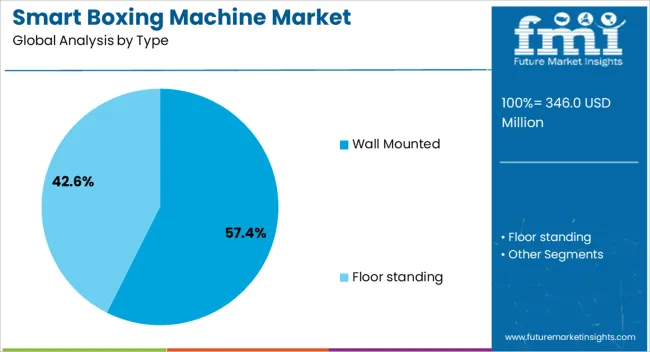
The wall-mounted segment, holding 57.4% of the type category, has maintained its dominance due to its space-saving design and suitability for both commercial and residential environments. Its popularity has been driven by the ability to integrate seamlessly into smaller workout areas without compromising training functionality. The segment benefits from stable demand among fitness facilities seeking durable, low-maintenance solutions with high user throughput capacity.
Technological enhancements, such as real-time punch analysis, adaptive resistance, and connectivity with mobile applications, have increased user appeal. Cost efficiency over freestanding alternatives, along with reduced installation complexity, has further reinforced its adoption.
Manufacturers are focusing on offering customizable designs and adjustable height options to cater to varied user profiles, ensuring sustained relevance across diverse end-user segments.
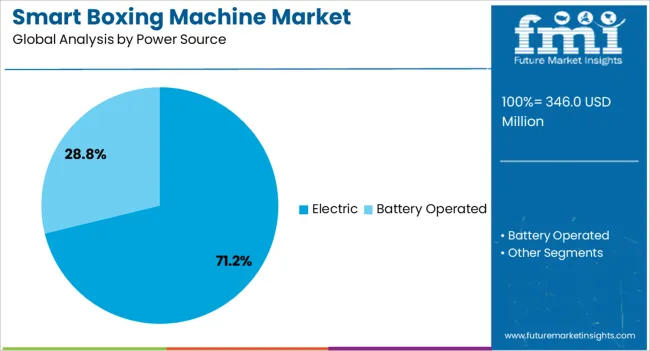
The electric segment, accounting for 71.2% of the power source category, has secured its leading position through its superior performance, precision, and adaptability. Electric smart boxing machines offer advanced programmable settings, real-time data feedback, and integration with virtual training platforms, enhancing the overall user experience.
This segment benefits from reduced maintenance compared to mechanical alternatives, as well as improved reliability in delivering consistent resistance and performance metrics. Growing demand from tech-savvy fitness enthusiasts and professional training centers has fueled its expansion.
Additionally, manufacturers are leveraging energy-efficient designs and battery backup features to address operational continuity during power outages. With continued advancements in IoT integration and software-driven customization, the electric segment is expected to retain its competitive edge, driving adoption in both high-end commercial facilities and premium home fitness setups.
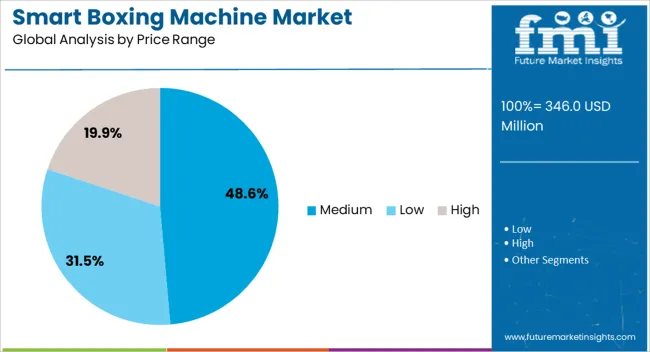
The medium price range segment, representing 48.6% of the price category, has emerged as the preferred choice for a broad consumer base seeking a balance between affordability and advanced functionality. This segment attracts budget-conscious buyers who prioritize performance features such as interactive displays, workout tracking, and adjustable resistance without incurring the premium costs of high-end models.
Its strong market position is supported by the availability of durable, well-equipped models from reputable brands targeting mid-market fitness facilities and home gyms. Competitive pricing strategies and bundled software packages have enhanced value perception among consumers.
Furthermore, the medium price range offers scalability for manufacturers to upgrade hardware and software features without significantly impacting production costs, enabling them to remain competitive while meeting evolving customer expectations.
The smart boxing machine market is expanding with the rising demand for connected fitness and combat sports training. Opportunities lie in AI integration and virtual coaching, while gamification and immersive workout trends are shaping the market landscape. However, challenges such as high costs and limited awareness in emerging regions may restrain adoption. Overall, the market is expected to grow steadily as consumers embrace interactive, engaging, and data-driven fitness experiences.
The smart boxing machine market is witnessing growing demand as consumers increasingly prefer connected fitness solutions. With a rise in home workouts, gyms, and training centers adopting interactive machines, the need for smart boxing devices is accelerating. These machines provide real-time feedback, performance tracking, and customizable training programs, appealing to both professional athletes and casual fitness enthusiasts. The growing popularity of combat sports and the rising integration of gamified training experiences have further contributed to strengthening demand for smart boxing machines worldwide.
The market holds significant opportunities through advancements in artificial intelligence and integration with virtual coaching platforms. AI-powered smart boxing machines can analyze punch strength, speed, and technique to provide tailored guidance. Partnerships with fitness apps and content creators further expand the appeal by offering interactive workouts and community-driven experiences. The adoption of subscription-based training content alongside machine sales presents recurring revenue opportunities for manufacturers. Expanding digital fitness ecosystems and the growing demand for personalized training are likely to create long-term growth prospects in this market.
A key trend in the smart boxing machine market is the incorporation of gamification and immersive experiences. Many systems now integrate augmented reality and virtual competitions, enabling users to challenge friends or participate in global leaderboards. Fitness gamification not only boosts engagement but also encourages consistency in training routines. Compact, portable designs combined with app-based interfaces are becoming increasingly popular among urban customers. The combination of smart wearables, biometric tracking, and gaming-style progression systems is reshaping the fitness equipment market, positioning smart boxing machines as a standout innovation.
Despite the growth prospects, the smart boxing machine market faces challenges such as high upfront costs and limited awareness in developing regions. Premium machines integrated with AI, AR, and advanced sensors remain unaffordable for many households. Gyms and fitness centers in cost-sensitive markets often hesitate to invest in such technologies due to uncertain return on investment. Lack of awareness about the long-term fitness benefits of smart boxing machines also limits adoption.
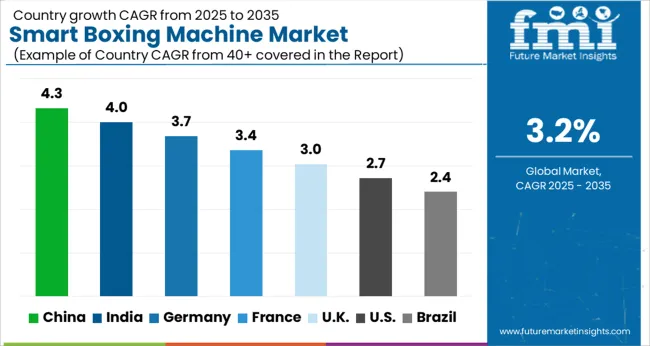
| Country | CAGR |
|---|---|
| China | 4.3% |
| India | 4.0% |
| Germany | 3.7% |
| France | 3.4% |
| UK | 3.0% |
| USA | 2.7% |
| Brazil | 2.4% |
The global smart boxing machine market is projected to record a CAGR of 3.2% during 2025–2035. China holds the lead with a 4.3% growth rate, followed closely by India at 4% and Germany at 3.7%. The United Kingdom maintains steady progress at 3%, while the United States records a relatively modest 2.7%. Growth is driven by increasing demand for interactive fitness equipment, rising adoption of AI-driven sports technology, and growing investment in gyms, gaming centers, and training facilities. While China and India show strong momentum due to their large youth population and interest in connected fitness, European markets such as Germany and the UK are focusing on integrating these machines into commercial gyms. The USA reflects slower but consistent growth, supported by niche adoption in fitness centers and recreational venues. This report includes insights on 40+ countries; the top markets are shown here for reference.
The smart boxing machine market in China is expected to expand at a 4.3% CAGR, supported by rising demand for interactive sports and fitness equipment. The country’s large youth population and growing interest in digital fitness platforms are fueling adoption in urban gyms, arcades, and shopping centers. Chinese manufacturers are also investing in locally produced machines that integrate mobile app connectivity, AI-driven training analysis, and personalized workout modes. E-sports culture and the popularity of skill-based entertainment are further boosting the market. Commercial entertainment venues, including malls and gaming zones, remain strong contributors to demand. With rising disposable income and health awareness, China is becoming a global hub for smart boxing machine adoption, driving export opportunities for domestic manufacturers.
The smart boxing machine market in India is projected to grow at 4% CAGR, fueled by rising interest in fitness technology and interactive entertainment. Urban gyms, shopping malls, and family entertainment centers are adopting smart boxing machines to attract young consumers seeking engaging experiences. India’s expanding middle-class population, with increasing disposable income, supports growth in premium fitness and gaming solutions. Local distributors are partnering with international manufacturers to introduce affordable machines customized for Indian buyers. Growing popularity of combat sports and digital fitness platforms is reinforcing demand. The combination of entertainment value and fitness benefits positions smart boxing machines as a growing category in India’s evolving leisure and health sector.
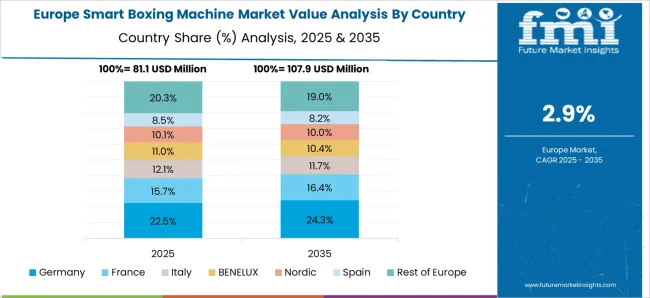
The smart boxing machine market in Germany is forecast to expand at 3.7% CAGR, supported by the country’s strong fitness culture and widespread adoption of connected training solutions. Gyms, fitness clubs, and recreation centers are introducing smart boxing machines to enhance member engagement and offer data-driven training experiences. German consumers are inclined toward durable, high-performance machines integrated with advanced technology, including biometric tracking and real-time performance monitoring. Manufacturers are focusing on models that meet stringent EU quality and safety standards, which boosts trust and long-term adoption. Growth is also supported by commercial installations in leisure venues, including entertainment complexes and shopping arcades. With a strong balance between fitness and entertainment, Germany is positioned as a stable growth market in Europe.
The smart boxing machine market in the United Kingdom is anticipated to grow at 3% CAGR, reflecting moderate but steady adoption. Commercial gyms, training facilities, and gaming centers are driving demand as consumers seek interactive and immersive fitness solutions. The UK has witnessed rising interest in gamified fitness, where boxing machines offer both entertainment and health benefits. Demand is largely urban-centric, with installations in malls, leisure zones, and youth entertainment hubs. Manufacturers are focusing on compact, space-efficient models suitable for smaller venues. Government-backed initiatives promoting fitness and active lifestyles indirectly support the market, while digital integration enhances user appeal. Although adoption is not as rapid as in Asia, the UK maintains a stable market position with consistent commercial investment.
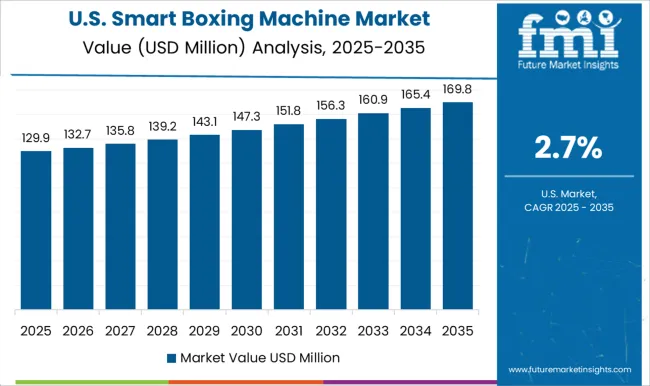
The smart boxing machine market in the United States is forecast to expand at 2.7% CAGR, reflecting slower growth compared to Asia and Europe. Adoption is mainly driven by niche markets, including high-end gyms, sports training centers, and entertainment venues. Fitness enthusiasts in metropolitan regions are increasingly drawn to interactive and gamified training experiences, though the broader market is dominated by traditional fitness equipment. Commercial installations in family entertainment centers, arcades, and malls are emerging as a growth segment, but scale remains limited compared to China and India. USA manufacturers emphasize premium machines with advanced biometric sensors, cloud-based data tracking, and competitive play features to attract enthusiasts. While growth is modest, the USA maintains a steady demand base focused on premium experiences.
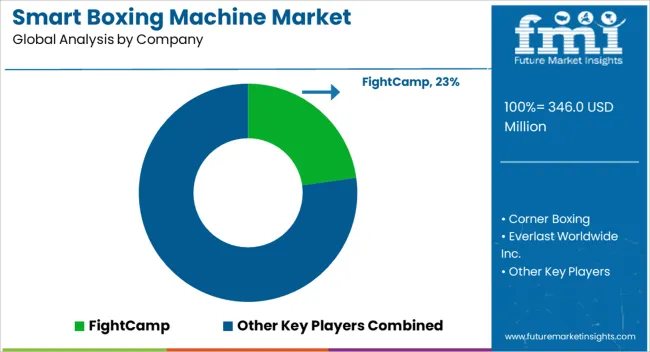
Key companies in the smart boxing machine market, such as FightCamp, Liteboxer, and Nexersys, are positioning themselves strongly by integrating fitness with interactive technology. FightCamp emphasizes home boxing systems with punch tracking sensors and streaming workouts, showcased in brochures as a blend of cardio training and entertainment. Liteboxer markets its wall-mounted and freestanding machines with rhythm-based training, gamification, and guided programs, appealing to both casual fitness users and athletes. Nexersys highlights AI-driven training with real-time feedback, portraying its products as effective for skill improvement and high-intensity training. Everlast Worldwide Inc. and Ringside, already established names in boxing equipment, are leveraging their strong brand recognition by introducing smart boxing devices that combine durability with digital features.
Hykso and StrikeTec specialize in punch trackers and wearable devices that integrate with apps for analytics and performance monitoring. SkyTechSport Inc. brings simulation-based boxing technology into gyms and training facilities, while PIQ focuses on smart sensors tailored for athletes seeking data-driven performance insights. Corner Boxing and UBX expand the market by blending connected training equipment with community-driven fitness experiences.
| Item | Value |
|---|---|
| Quantitative Units | USD 346.0 Million |
| Type | Wall Mounted and Floor standing |
| Power Source | Electric and Battery Operated |
| Price Range | Medium, Low, and High |
| Application | Residential and Commercial |
| Distribution Channel | Online and Offline |
| Regions Covered | North America, Europe, Asia-Pacific, Latin America, Middle East & Africa |
| Country Covered | United States, Canada, Germany, France, United Kingdom, China, Japan, India, Brazil, South Africa |
| Key Companies Profiled | FightCamp, Corner Boxing, Everlast Worldwide Inc., Hykso, Liteboxer, Nexersys, PIQ, Ringside, SkyTechSport Inc., StrikeTec, and UBX |
| Additional Attributes | Dollar sales by machine type (standalone, integrated) and end-use (gyms, homes, training centers) are key metrics. Trends include rising demand for connected fitness equipment, integration with AI and performance tracking, and growth in home fitness adoption. Regional adoption, technological innovations, and shifting consumer lifestyles are driving market growth. |
The global smart boxing machine market is estimated to be valued at USD 346.0 million in 2025.
The market size for the smart boxing machine market is projected to reach USD 474.1 million by 2035.
The smart boxing machine market is expected to grow at a 3.2% CAGR between 2025 and 2035.
The key product types in smart boxing machine market are wall mounted and floor standing.
In terms of power source, electric segment to command 71.2% share in the smart boxing machine market in 2025.






Full Research Suite comprises of:
Market outlook & trends analysis
Interviews & case studies
Strategic recommendations
Vendor profiles & capabilities analysis
5-year forecasts
8 regions and 60+ country-level data splits
Market segment data splits
12 months of continuous data updates
DELIVERED AS:
PDF EXCEL ONLINE
Smart Magnetic Drive Conveyor System Market Size and Share Forecast Outlook 2025 to 2035
Smart Wheelchair market Size and Share Forecast Outlook 2025 to 2035
Smart Mining Technologies Market Size and Share Forecast Outlook 2025 to 2035
Smart Parking Market Size and Share Forecast Outlook 2025 to 2035
Smart Digital Valve Positioner Market Forecast and Outlook 2025 to 2035
Smart Card IC Market Size and Share Forecast Outlook 2025 to 2035
Smart-Tag Inlay Inserters Market Analysis - Size and Share Forecast Outlook 2025 to 2035
Smart TV Market Forecast and Outlook 2025 to 2035
Smart/AI Toy Market Size and Share Forecast Outlook 2025 to 2035
Smart Locks Market Size and Share Forecast Outlook 2025 to 2035
Smart Sprinkler Controller Market Size and Share Forecast Outlook 2025 to 2035
Smart Indoor Gardening System Market Size and Share Forecast Outlook 2025 to 2035
Smart Building Delivery Robot Market Size and Share Forecast Outlook 2025 to 2035
Smart Watch Market Size and Share Forecast Outlook 2025 to 2035
Smart Label Market Size and Share Forecast Outlook 2025 to 2035
Smart Mat Market Size and Share Forecast Outlook 2025 to 2035
Smart Water Management Market Size and Share Forecast Outlook 2025 to 2035
Smart Built-In Kitchen Appliance Market Size and Share Forecast Outlook 2025 to 2035
Smart Personal Assistance Devices Market Size and Share Forecast Outlook 2025 to 2035
Smart Speaker Market Size and Share Forecast Outlook 2025 to 2035

Thank you!
You will receive an email from our Business Development Manager. Please be sure to check your SPAM/JUNK folder too.
Chat With
MaRIA